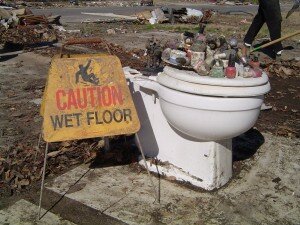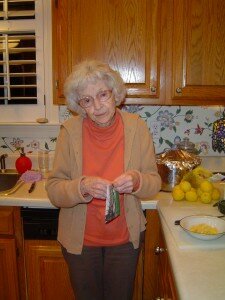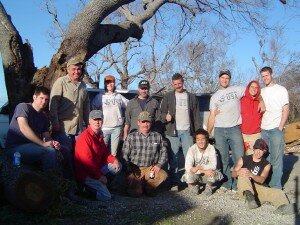Photographic Memories: Katrina Volunteers & Disaster Relief
 by Chris de Veer, former Volunteer & Director of Hands On Gulf Coast (2006 – 2008)
by Chris de Veer, former Volunteer & Director of Hands On Gulf Coast (2006 – 2008)
It’s been five years since Hurricane Katrina slammed into the Gulf Coast inflicting tens of billions of dollars in damages and upending the lives of hundreds of thousands of people.
The tragedy that unfolded on national television compelled hundreds of thousands of people across the US to volunteer their time, their money, and their skills to help rebuild the Gulf Coast.
I was one of those who volunteered. Katrina had struck my family. Although my immediately family lived in Virginia, my grandma, who was 83 at the time, as well as aunts, uncles, and cousins lived in and around New Orleans.
No one was injured, but my grandma and an uncle lost their houses to flooding and muck. Going to help with the recovery felt less like volunteering and more like doing what needed to be done.
I landed in Biloxi, Mississippi in mid-January 2006; my initial three-week volunteer trip turned into a two-and-a-half year experience.
The impressions and the scope of my early days volunteering still resonate starkly.
When I first arrived on a plane into Gulfport, I was picked up at the airport and we headed back to what was affectionately called ‘Base’, or the volunteer warehouse as I also liked to think of it.
I couldn’t help but notice all the blue-tarped roofs.
They were everywhere and the blue stood in stark contrast to the brown-ish drab of winter.
Despite coming in by plane, I had no idea how far the damage stretched or how thorough some neighborhoods had been decimated.
 The first neighborhood I visited was East Biloxi, home to many Vietnamese and African Americans.
The first neighborhood I visited was East Biloxi, home to many Vietnamese and African Americans.
The job the volunteer team needed to accomplish was to clean up the site of a former building.
I’m not even sure what was there, but from the debris it appeared to be some sort of a shop and residence.
There was little left, but the toilet had not been damaged. It sat in the open.
As we collected garbage into piles, we found items that someone might want to salvage – nail polish, statues, and a small photo album.
I don’t remember the content of the photo album, but I do remember those photos making the horror of the loss very real and very present.
We have photos to remind us of good times, to remind us of loved ones. And here those special memory triggers were, lying in a pile of garbage that would wind up in a land fill. The photos put faces to the ethereal family that had lived or worked here.
 Two years before Katrina, I visited my Grandma, pulled out her photo albums, scanned in every photo, made a database, and asked her to identify everyone in every photo, estimate when the photo was taken, and describe what was going on.
Two years before Katrina, I visited my Grandma, pulled out her photo albums, scanned in every photo, made a database, and asked her to identify everyone in every photo, estimate when the photo was taken, and describe what was going on.
Most photos had a story or triggered a memory that led to a smile.
Who knew that in two years (from August 2003 to August 2005), these scanned photos would be one of the few records of my grandma’s 59 years in her Gulf Coast home?
Who knew that a lifeless husk of a house would greet me the next time I visited.
Who knew I would lose the home where I had lived during first grade, the home where my Dad grew up, the home where my grandmother lived ever since she emigrated from Scotland to marry my granddad after World War II.
Even though my family had cleaned up a bit and tried to salvage some items from the Katrina muck, the house was still a wreck.
My grandma showed me her neighborhood.
Few people were around.
She took me to St Raphael’s, where I went to first grade, and I saw the empty halls that still bore the high-water mark of stagnant Katrina water.
She then took me to Ferrara’s, her grocery store, where I remember having the most delicious French bread.
No one had even cleaned out the meat refrigerators or touched the shelves.
The st ench of rot was overpowering.
ench of rot was overpowering.
All across her neighborhood, an eerie quiet had settled.
We didn’t even need to look for traffic when we made our turns. We had the roads to ourselves.
A few weeks later, a group of volunteers went to my grandma’s to gut the place and get it ready for rebuilding.
Although it was gutted in a day, it took another two years to get any money from the Road Home Fund for rebuilding.
The Road Home was Louisiana’s program to disburse federal rebuilding funds to qualified homeowners.
In 2008 when she received her money, my grandma found another house near an uncle in Covington.
The house on Peoples Avenue in Gentilly would sit another two years before my youngest uncle would have the opportunity to begin to rebuild.
 I know my grandmother was lucky compared to many other victims of Katrina.
I know my grandmother was lucky compared to many other victims of Katrina.
My family was able to provide a safety net for my grandma and helped her into a new house within months of the storm’s passing.
Others on the Gulf Coast were not so lucky.
At Hands On Gulf Coast, we made a point of finding families that other organizations could not help, particularly when it came to rebuilding homes.
We sent volunteers to tutor kids in schools, to clean up parks, to work with the Boys and Girls Club, to even micro-chip pets.
There wasn’t a job our volunteers wouldn’t do.
From January 2006 through May 2008, I saw volunteers and the community slowly and steadily reweave the tapestry of Gulf Coast life.
Schools, parks, homes, businesses, restaurants, and stores all showed signs coming back to life.
I am proud of the thousands who volunteered with us.
I’m proud of the volunteers who joined AmeriCorps or became staff members at Hands On or other community nonprofits.
I hope a disaster like Katrina never happens in the region again, but I know that should it, hundreds of thousands more volunteers will come down to help with the recovery.


